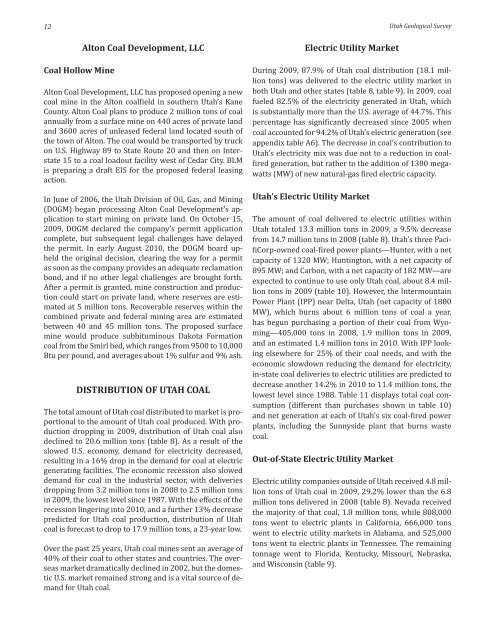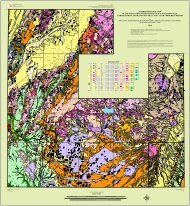Annual review and forecast of Utah coal - Utah Geological Survey ...
Annual review and forecast of Utah coal - Utah Geological Survey ...
Annual review and forecast of Utah coal - Utah Geological Survey ...
Create successful ePaper yourself
Turn your PDF publications into a flip-book with our unique Google optimized e-Paper software.
12<br />
<strong>Utah</strong> <strong>Geological</strong> <strong>Survey</strong><br />
Coal Hollow Mine<br />
Alton Coal Development, LLC<br />
Alton Coal Development, LLC has proposed opening a new<br />
<strong>coal</strong> mine in the Alton <strong>coal</strong>field in southern <strong>Utah</strong>’s Kane<br />
County. Alton Coal plans to produce 2 million tons <strong>of</strong> <strong>coal</strong><br />
annually from a surface mine on 440 acres <strong>of</strong> private l<strong>and</strong><br />
<strong>and</strong> 3600 acres <strong>of</strong> unleased federal l<strong>and</strong> located south <strong>of</strong><br />
the town <strong>of</strong> Alton. The <strong>coal</strong> would be transported by truck<br />
on U.S. Highway 89 to State Route 20 <strong>and</strong> then on Interstate<br />
15 to a <strong>coal</strong> loadout facility west <strong>of</strong> Cedar City. BLM<br />
is preparing a draft EIS for the proposed federal leasing<br />
action.<br />
In June <strong>of</strong> 2006, the <strong>Utah</strong> Division <strong>of</strong> Oil, Gas, <strong>and</strong> Mining<br />
(DOGM) began processing Alton Coal Development’s application<br />
to start mining on private l<strong>and</strong>. On October 15,<br />
2009, DOGM declared the company’s permit application<br />
complete, but subsequent legal challenges have delayed<br />
the permit. In early August 2010, the DOGM board upheld<br />
the original decision, clearing the way for a permit<br />
as soon as the company provides an adequate reclamation<br />
bond, <strong>and</strong> if no other legal challenges are brought forth.<br />
After a permit is granted, mine construction <strong>and</strong> production<br />
could start on private l<strong>and</strong>, where reserves are estimated<br />
at 5 million tons. Recoverable reserves within the<br />
combined private <strong>and</strong> federal mining area are estimated<br />
between 40 <strong>and</strong> 45 million tons. The proposed surface<br />
mine would produce subbituminous Dakota Formation<br />
<strong>coal</strong> from the Smirl bed, which ranges from 9500 to 10,000<br />
Btu per pound, <strong>and</strong> averages about 1% sulfur <strong>and</strong> 9% ash.<br />
DISTRIBUTION OF UTAH COAL<br />
The total amount <strong>of</strong> <strong>Utah</strong> <strong>coal</strong> distributed to market is proportional<br />
to the amount <strong>of</strong> <strong>Utah</strong> <strong>coal</strong> produced. With production<br />
dropping in 2009, distribution <strong>of</strong> <strong>Utah</strong> <strong>coal</strong> also<br />
declined to 20.6 million tons (table 8). As a result <strong>of</strong> the<br />
slowed U.S. economy, dem<strong>and</strong> for electricity decreased,<br />
resulting in a 16% drop in the dem<strong>and</strong> for <strong>coal</strong> at electric<br />
generating facilities. The economic recession also slowed<br />
dem<strong>and</strong> for <strong>coal</strong> in the industrial sector, with deliveries<br />
dropping from 3.2 million tons in 2008 to 2.5 million tons<br />
in 2009, the lowest level since 1987. With the effects <strong>of</strong> the<br />
recession lingering into 2010, <strong>and</strong> a further 13% decrease<br />
predicted for <strong>Utah</strong> <strong>coal</strong> production, distribution <strong>of</strong> <strong>Utah</strong><br />
<strong>coal</strong> is <strong>forecast</strong> to drop to 17.9 million tons, a 23-year low.<br />
Over the past 25 years, <strong>Utah</strong> <strong>coal</strong> mines sent an average <strong>of</strong><br />
40% <strong>of</strong> their <strong>coal</strong> to other states <strong>and</strong> countries. The overseas<br />
market dramatically declined in 2002, but the domestic<br />
U.S. market remained strong <strong>and</strong> is a vital source <strong>of</strong> dem<strong>and</strong><br />
for <strong>Utah</strong> <strong>coal</strong>.<br />
Electric Utility Market<br />
During 2009, 87.9% <strong>of</strong> <strong>Utah</strong> <strong>coal</strong> distribution (18.1 million<br />
tons) was delivered to the electric utility market in<br />
both <strong>Utah</strong> <strong>and</strong> other states (table 8, table 9). In 2009, <strong>coal</strong><br />
fueled 82.5% <strong>of</strong> the electricity generated in <strong>Utah</strong>, which<br />
is substantially more than the U.S. average <strong>of</strong> 44.7%. This<br />
percentage has significantly decreased since 2005 when<br />
<strong>coal</strong> accounted for 94.2% <strong>of</strong> <strong>Utah</strong>’s electric generation (see<br />
appendix table A6). The decrease in <strong>coal</strong>’s contribution to<br />
<strong>Utah</strong>’s electricity mix was due not to a reduction in <strong>coal</strong>fired<br />
generation, but rather to the addition <strong>of</strong> 1300 megawatts<br />
(MW) <strong>of</strong> new natural-gas fired electric capacity.<br />
<strong>Utah</strong>’s Electric Utility Market<br />
The amount <strong>of</strong> <strong>coal</strong> delivered to electric utilities within<br />
<strong>Utah</strong> totaled 13.3 million tons in 2009, a 9.5% decrease<br />
from 14.7 million tons in 2008 (table 8). <strong>Utah</strong>’s three PacifiCorp-owned<br />
<strong>coal</strong>-fired power plants—Hunter, with a net<br />
capacity <strong>of</strong> 1320 MW; Huntington, with a net capacity <strong>of</strong><br />
895 MW; <strong>and</strong> Carbon, with a net capacity <strong>of</strong> 182 MW—are<br />
expected to continue to use only <strong>Utah</strong> <strong>coal</strong>, about 8.4 million<br />
tons in 2009 (table 10). However, the Intermountain<br />
Power Plant (IPP) near Delta, <strong>Utah</strong> (net capacity <strong>of</strong> 1800<br />
MW), which burns about 6 million tons <strong>of</strong> <strong>coal</strong> a year,<br />
has begun purchasing a portion <strong>of</strong> their <strong>coal</strong> from Wyoming—405,000<br />
tons in 2008, 1.9 million tons in 2009,<br />
<strong>and</strong> an estimated 1.4 million tons in 2010. With IPP looking<br />
elsewhere for 25% <strong>of</strong> their <strong>coal</strong> needs, <strong>and</strong> with the<br />
economic slowdown reducing the dem<strong>and</strong> for electricity,<br />
in-state <strong>coal</strong> deliveries to electric utilities are predicted to<br />
decrease another 14.2% in 2010 to 11.4 million tons, the<br />
lowest level since 1988. Table 11 displays total <strong>coal</strong> consumption<br />
(different than purchases shown in table 10)<br />
<strong>and</strong> net generation at each <strong>of</strong> <strong>Utah</strong>’s six <strong>coal</strong>-fired power<br />
plants, including the Sunnyside plant that burns waste<br />
<strong>coal</strong>.<br />
Out-<strong>of</strong>-State Electric Utility Market<br />
Electric utility companies outside <strong>of</strong> <strong>Utah</strong> received 4.8 million<br />
tons <strong>of</strong> <strong>Utah</strong> <strong>coal</strong> in 2009, 29.2% lower than the 6.8<br />
million tons delivered in 2008 (table 8). Nevada received<br />
the majority <strong>of</strong> that <strong>coal</strong>, 1.8 million tons, while 808,000<br />
tons went to electric plants in California, 666,000 tons<br />
went to electric utility markets in Alabama, <strong>and</strong> 525,000<br />
tons went to electric plants in Tennessee. The remaining<br />
tonnage went to Florida, Kentucky, Missouri, Nebraska,<br />
<strong>and</strong> Wisconsin (table 9).

















